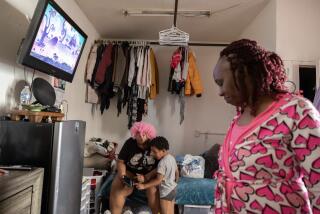‘Sick Buildings’ Linked to Fatal Lung Condition
- Share via
Eyes weepy? Can’t breathe? Feeling dizzy?
Could be you’re suffering from “sick building” syndrome.
Scientists have known for some time that this ailment, caused by today’s energy-efficient, tightly sealed office buildings, leads to general malaise and lost productivity for workers.
But in a paper presented at the annual meeting of the American Academy of Allergy and Immunology in Anaheim on Wednesday, University of Michigan microbiologist Harriet A. Burge said the syndrome can lead to death.
Burge said she and her research team found that tightly sealed buildings with poor ventilation systems spawn fungi that can cause a potentially fatal lung condition, hypersensitivity pneumonitis.
‘Just Not Something in People’s Heads’
“ ‘Sick building’ syndrome is just not something in people’s heads, as building managers would like for us to believe,” said Burge, who heads the allergy research laboratory at the University of Michigan Medical School.
People afflicted with the lung disorder get fever, chills, muscle aches and chest pains, she said.
Fungi causing this lung ailment have been found in a few other studies, Burge said. But she believes that this organism would be found much more often in buildings if others used the sophisticated tests employed by her research team in March and July, 1987, in a 15-story federal office building in Washington.
The 20-year-old building was designed for condominiums but was converted for offices, Burge said.
“But they didn’t upgrade the ventilation system to take into account the larger number of people who use a commercial building than use a residential building,” she said.
The inadequate ventilation has been compounded by poor maintenance that allows air filters to clog and the refusal of the building’s management to run the ventilating system through the weekend, she said.
‘Fertile Breeding Ground for Fungi’
“Building managers just won’t run their ventilating systems over the weekend because it’s so expensive,” Burge said. “But they should do so because the humidity rises, which is a fertile breeding ground for fungi.”
Burge’s study was paid for by the federal government, which has prohibited her from identifying the building by name, she said.
But she noted that federal authorities have told her that they plan to replace the ventilation system. She estimated that this will cost several million dollars.
And the National Institute of Occupational Safety and Health, which paid for the study, is considering adopting Burge’s techniques as the standard for studies of other “sick buildings,” she said.






